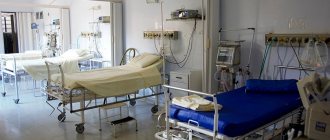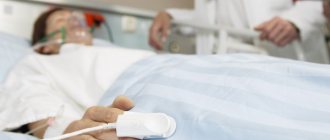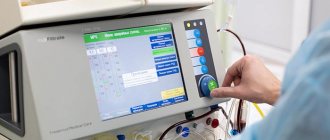Girls, I have a question, I can’t find anything useful on the Internet.
The situation is this: my dad has been in therapy in the hospital for 3-4 weeks now. He has serious problems with his liver, lungs, heart, serious exhaustion, in short, the whole package. He almost never gets out of bed. The treatment does not help, the doctor does not give any hope, he said they will give him something to support him, but he cannot be saved. He said just to prepare for the outcome, he also didn’t give a time frame, he said maybe a week or maybe a month.
But! Over the weekend, my relatives called and said that the doctor (or nurse) said that they could keep me for another 2 weeks, and then I needed to either take him home or agree to be transferred to a regional hospice.
The actual question is: how long are they required by law to keep a patient in the hospital? If he's lying down, they won't put him out on the street if they don't pick him up? Are there any clear deadlines or is it realistic - 1.5 months are required, and then at will?
In this article I want to answer a question that interests many. It concerns the timing of treatment in a neurological hospital for round-the-clock and day stays. There are several different aspects that affect the length of treatment, including the diagnosis, what type of hospitalization was performed, and much more. I'll tell you about everything in more detail. So, how long do they stay in hospital?
In the Russian Federation there are two types of the concept of hospitalization. The first is emergency hospitalization. In this case, the patient or people nearby call an ambulance team, indications for hospital treatment are urgently determined on the spot, and the person is taken away. Sometimes there is a suspicion of a stroke, then the patient is initially admitted to the vascular center, where the diagnosis is clarified. If the diagnosis is negative, the patient is usually transferred to an emergency neurological hospital, which is on duty that day in the city/district/region. If there is no doubt about the diagnosis or it is not possible to exclude or confirm the diagnosis, the person is hospitalized in the vascular center.
The duration of treatment in the vascular center, as well as in any other neurological department, depends on the severity of the patient. It is clear that if there remains a threat to a person’s life, he will not be discharged. However, if the patient is not in danger, his health has improved, even if not all functions have been restored, then the patient is discharged, on average this happens 21 days after the start of treatment. His further fate is outpatient treatment and rehabilitation in specialized centers, as well as in sanatorium-resort conditions.
Treatment of an emergency patient in the absence of a stroke is carried out in a specialized neurological hospital that accepts emergency patients and has appropriate conditions (availability of personnel, equipment, provision of specific medications, availability of an intensive care unit, etc.).
The patient also has the right to apply for planned inpatient treatment in the event of initial illness in the following situations:
- A person has a chronic disease that requires regular monitoring (for example, multiple sclerosis, drug-resistant form of epilepsy).
- There is a neurodegenerative disease (for example, amyotrophic lateral sclerosis, Wilson-Konovalov disease).
- There is a deterioration of another chronic process (dyscirculatory encephalopathy, diabetic polyneuropathy, consequences of stroke, etc.).
- There is an exacerbation of the chronic vertebrogenic process (cervicalgia, lumbodynia, lumbar ischialgia, etc.).
Planned inpatient treatment is provided to people with a referral for hospitalization and a clinical minimum of tests and studies. Moreover, the word planned itself implies a queue. If the situation is urgent, you should call an ambulance.
Treatment in the planned neurological department is divided into day hospital and 24-hour hospital. The duration of treatment in a day bed is 9-10 days, with both the day of admission and the day of discharge being considered a day. A 24-hour hospital bed is longer; the course of treatment takes from 11 to 14 days. Exceeding the duration of a 24-hour stay (due to the severity of the condition, insufficient examination of technical problems that have already been resolved, or other serious reasons) is possible, but only after going through the procedure of a meeting of a medical commission headed by the deputy chief physician for medical work. And, of course, relying only on the patient’s desire (I want to lie down longer, I need to “dig around” more, I want to undergo an examination from head to toe, even if I don’t have any indications, but suddenly there is something there, etc. .), the commission will issue a negative verdict.
Treatment of sinusitis in the hospital: how long to lie after a puncture
Many have heard or encountered such an unpleasant disease as sinusitis more than once. You can treat it either with the help of a specialist or on your own (by choosing medications recommended by relatives or friends). The problem is that the medications you choose yourself may not only be useless, but also aggravate the situation, so it is important to consult a specialist in a timely manner. Many people are interested in questions about how sinusitis is treated in the hospital and how many days you need to stay with sinusitis.
If antibiotics have no effect on the treatment process, “Cuckoo” did not help and all the heating and irradiation did not give the desired results, surgery comes to the rescue. In a hospital, the main method of surgical therapy is sinusotomy: the sinuses are opened, as well as pus is removed from them.
Dispensary observation
As a rule, if there are no complications and indications for surgery, hospitalization is carried out in the pulmonology department of a therapeutic hospital . If the hospital does not have a pulmonology department, the patient may be admitted to a regular therapeutic department.
If the patient is in serious condition, he is transferred to the intensive care unit. If surgical intervention is necessary (drainage of the pleural cavity, lobectomy, pneumonectomy, etc.), the patient is transferred to the surgical (thoracic) department.
Patient admission and diagnosis
Upon admission to the hospital, the patient undergoes a series of instrumental and laboratory tests to confirm the diagnosis, determine the clinical picture of the disease and further treatment tactics. These include:
- Plain X-ray of the chest (in two projections). This study is one of the main ones and allows you to assess the size of the inflammatory infiltrate, its localization (left-sided, right-sided, bilateral). In the future, when comparing images, one can judge the dynamics of the process.
- Microbiological examination of sputum to determine the pathogen and its sensitivity to antibiotics.
- General and biochemical blood tests .
- General urine analysis .
If, after all the above studies, the doctor still has questions, he can conduct a number of additional studies (CT, puncture of the pleural cavity, PCR, etc.).
Therapy
After the patient is admitted to the hospital, the doctor immediately begins empirical (without specifying the pathogen) antibiotic therapy, adjusting the treatment regimen every 2 days (if necessary).
As a rule, broad-spectrum antibiotics (penicillins, cephalosporins, macrolides, fluoroquinolones, aminoglycosides, carbapenems) are used for this purpose.
The course of treatment depends on the severity of the condition and the type of pneumonia (nosocomial or community-acquired). After establishing the pathogen and its sensitivity to antibiotics, the drugs are changed taking into account these data (if necessary).
Important! Antibiotic therapy lasts from 7 to 14 days, with the dynamics of the patient’s condition assessed every day and if there is no positive effect within 48 hours, the antibiotic is changed.
The effectiveness of antibacterial agents is evidenced by the following criteria:
- reduction of symptoms of intoxication,
- normalization of body temperature,
- the amount of pus in the sputum decreases,
- in the general blood test, indicators indicating the presence of inflammation (leukocytes, ESR) return to normal or decrease,
- positive dynamics are observed with repeated x-ray examination and auscultation of the lungs,
- the patient's general condition improves.
Antibiotics are the etiological treatment, and other types of therapy only relieve symptoms and strengthen the body as a whole. These include:
- immunostimulants,
- antipyretics,
- mucolytics and expectorants,
- inhalation therapy.
After stabilization of the condition, physiotherapy is prescribed:
- ultra high frequency therapy,
- electrophoresis with drugs,
- inhalations,
- inductothermy,
- chest massage,
- physiotherapy.
Physiotherapy helps to quickly clear the source of inflammation and speed up recovery.
Mode and nutrition
Until the patient's condition stabilizes during the period of intoxication and fever, the patient is prescribed bed rest. After the fever has been relieved and the patient’s condition has stabilized, the patient is transferred to the usual regimen.
The diet should be high in calories, containing a lot of protein, easily digestible carbohydrates and rich in vitamins, macro- and microelements. In addition, the patient needs plenty of warm fluids (about 3 liters per day).
Proper nutrition and adherence to the regime promotes rapid improvement of the condition and affects the duration of the disease.
Read more about mode and nutrition >,>,
Possible outcomes
How long pneumonia lasts and its outcome largely depend on the type of pathogen, the correctness and timeliness of the treatment started. They may be as follows:
- complete recovery,
- transition to a long current,
- limited pneumosclerosis (replacement of lung tissue with connective tissue),
- chronic bronchitis (post-pneumonic),
- complications (abscess formation, pleurisy, pyothorax),
- post-infectious syndrome (long-term persistence of low-grade fever, weakness, etc.).
Child in hospital: parents' rights
In accordance with paragraph 3 of Article 51 and paragraph 4 of part 3 of Article 80 of the Federal Law of November 21, 2011 No. 323-FZ “On the fundamentals of protecting the health of citizens in the Russian Federation,” one of the parents, another family member or other legal representative is granted the right to free joint stay with a child in a medical organization when providing medical care in an inpatient setting during the entire period of treatment, regardless of the child’s age.
Thus, any of the parents (mother or father) or any other family member, regardless of the degree of relationship (grandmother, aunt, sister) of a child under 4 years of age or a child over this age who needs care, is allowed to stay in hospital during the entire period of treatment (stay) of the child in the hospital. In this case, the hospital must provide the parent or other relative not only with food, but also with a place to sleep.
GBUZ SK Essentuki city clinic
The municipal service includes examination and treatment in a day hospital. Municipal services are provided free of charge as part of the compulsory health insurance program if you have a compulsory health insurance policy on a scheduled basis.
Emergency medical care is not provided in the day hospital. Recipients of the service are individuals who applied to a day hospital for medical care within the framework of compulsory health insurance. The purpose of providing a municipal service is to provide qualified primary health care in a day hospital setting. The duration of the service depends on the severity of the disease (diagnosis). To receive municipal services, the applicant must submit:
1. Identification document (to be presented): - passport of a citizen of the Russian Federation;
- birth certificate. 2. Compulsory medical insurance policy of the Russian Federation. 3. Referral from the attending physician. To receive a municipal service, the applicant:
- makes an appointment with the head of the department or a DS doctor for an initial examination;
— provides documents; — is registered in the DS or receives a reasoned refusal; — complies with the doctor’s instructions and prescriptions; — attends prescribed procedures; — undergoes prescribed clinical diagnostic examinations; — complies with the DS regime in accordance with the procedure established by the chief physician of the clinic; - upon completion of treatment, receives a statement from the attending physician with further recommendations. Waiting period in the queue:
- for hospitalization in the day hospital of the State Budgetary Healthcare Institution up to 30 days (depending on the availability of places) - treatment in the day hospital depending on the diagnosis and course of the disease.
Grounds for refusal of admission:
- lack of a compulsory medical insurance policy;
— lack of an identity document; Grounds for refusal to provide a service:
— presence of contraindications;
— lack of indications for day hospital; — the applicant’s refusal to receive treatment; GENERAL INDICATIONS FOR HOSPITALIZATION IN A DAY HOSPITAL
The following patients can be sent for treatment to the day hospital of a polyclinic: - those who are registered at the dispensary for vegetative-vascular dystonia (VSD) and biliary dyskinesia (BD), and who do not require round-the-clock monitoring due to their health status, the use of medicinal products, after use of which medical supervision must be carried out for a certain time due to possible adverse reactions;
— those in need of intravenous drip administration of drugs; - those in need of complex treatment using physiotherapy, massage, physical therapy, after which rest is necessary, as well as the administration of medications in various ways at certain intervals. GENERAL CONTRAINDICATIONS FOR HOSPITALIZATION IN A DAY HOSPITAL In a
day hospital, the stay of patients is contraindicated: - those in need of round-the-clock medical supervision and medical care, parenteral round-the-clock administration of medications;
requiring bed rest; - having a severe concomitant disease, a complication of the main disease that developed during treatment in a day hospital; - with frequent exacerbations at night until the condition stabilizes; - with severely limited ability to move independently; - conditions that require strict adherence to a dietary regimen, and which cannot be fulfilled in a clinic setting; - health and condition that may worsen when exposed to cold air or heat on the way to the day hospital and home. INTERNAL RULES OF A DAY HOSPITAL
The patient is obliged to: - take care of his own health, take timely measures to preserve, strengthen and restore it;
— treat healthcare workers and other patients with respect; — follow the recommendations of medical workers necessary to implement the chosen treatment tactics, cooperate with medical workers in the provision of medical care; - inform medical workers about the presence of diseases that pose a danger to public health, the human immunodeficiency virus, and also take precautions when contacting other persons; — inform medical workers about previously identified medical contraindications to the use of medicines, hereditary and past diseases, requests for medical help, as well as changes in health status; - follow the internal rules of the clinic, treat property with care. PROCEDURE FOR HOSPITALIZATION IN A DAY HOSPITAL
Hospitalization is carried out as planned. The patient must have an outpatient card and a referral from a doctor for hospitalization in a day hospital, a change of clothes and shoes. In case of refusal (from) hospitalization, the doctor of the day hospital makes a record in the register of patients' admission and refusals to hospitalize the reasons for the refusal to hospitalize and the measures taken with written acquaintance of the patient. The treatment plan (start date of treatment, duration of treatment, examination methods, time of arrival and duration of stay in a day hospital, etc.) of a patient in a day hospital is determined by a day hospital doctor for each patient individually. The patient is discharged after 12.00. Before discharge from the day hospital, a final examination of the patient is carried out by a doctor at the day hospital, and, if necessary, by a specialist doctor at the clinic who referred the patient to the day hospital. On the day the patient leaves the day hospital, the outpatient card is transferred to the attending physician through the registry with a completed epicrisis. The first copy of the epicrisis is pasted into the patient’s outpatient medical record, the second copy remains in the patient’s day hospital record. After the patient’s departure from the day hospital, a patient’s card from the day hospital is drawn up within 3 days and stored in the archives of the day hospital. In case of conflict situations, the patient has the right to contact the administration of the clinic in accordance with the schedule of reception of citizens approved by the chief physician of the clinic.
How many days do they stay in hospitals in Moscow after operations?
The list of operations is quite large and is constantly expanding. For example, in the ophthalmological SKP it is possible to cure cataracts, in the surgical one - benign neoplasms of soft tissues, skin, breast, hernia of the anterior abdominal wall, cholelithiasis, diseases of the rectum, varicose veins of the lower extremities. In gynecological SKP - dysplasia, erosion, polyps of the cervix and vulva, polyps and synechiae of the uterus, cysts of the Bartholin glands. In urology - kidney stones, ureteral stones, phimosis, hydrocele, spermatocele, varicocele.
My daughter is going to kindergarten for the first time. From my work colleague, whose son is already in preschool, I often hear complaints about the menu in the kindergarten. Parents are forced to address their comments to the head. I would like to know in advance what is prohibited to feed in kindergartens and where to go if the rules are violated?
Duration of sick leave after surgery - how many days
- Which doctors and organizations set the period and for how many days;
- Types of operations. What deadlines are applicable for different types;
- Is it possible to extend sick leave after its expiration;
- How is payment for the period of illness carried out, what factors influence the amount of benefits;
- What to do if the sick leave is closed.
- If an employee has undergone eye surgery, and his work involves spending a long time in front of a computer, then the employee can count on an extension of sick leave.
- If an employee has had surgery on his legs, for example, for varicose veins, then the period is extended to 30 days, but such a disease requires longer rest, so the employer must provide his employee with light work for another two or three months.
- If a woman has lost her fallopian tube or uterus during surgery, she must not lift heavy objects (up to 3 kg) for three months; the employer must also take this into account.
We recommend reading: Amount for Food 2020 for Liquidators of the Blackout Accident
Treatment of myocardial infarction in a hospital: how many days do they stay in hospital?
Eating occurs no earlier than 12 hours after the impact. Meals should be light, low-calorie and, most importantly, moderate. You should not overeat, consume a lot of salt (it is limited to a minimum), fats and water. The patient should take food often and in small portions. His diet includes porridge, lean fish and meat, boiled vegetables and soups with their broth, fruit purees, compotes, fruit drinks, and weak tea. At first, food should be eaten only in pureed form; after a couple of weeks, the diet should remain the same, but it will not be necessary to puree the food. Relatives, after their relative has gotten better, are interested in what can be transferred to the hospital in case of a heart attack. You don’t need to give anything special, just soaked dried fruits (for example, dried apricots, raisins) and peeled oranges. It is necessary to ensure that the products are not stale, but certainly fresh.
How many days do they stay in hospitals in Moscow after operations?
The list of operations is quite large and is constantly expanding. For example, in the ophthalmological SKP it is possible to cure cataracts, in the surgical one - benign neoplasms of soft tissues, skin, breast, hernia of the anterior abdominal wall, cholelithiasis, diseases of the rectum, varicose veins of the lower extremities. In gynecological SKP - dysplasia, erosion, polyps of the cervix and vulva, polyps and synechiae of the uterus, cysts of the Bartholin glands. In urology - kidney stones, ureteral stones, phimosis, hydrocele, spermatocele, varicocele.
My daughter is going to kindergarten for the first time. From my work colleague, whose son is already in preschool, I often hear complaints about the menu in the kindergarten. Parents are forced to address their comments to the head. I would like to know in advance what is prohibited to feed in kindergartens and where to go if the rules are violated?
Sick leave for child care
Let’s assume that employee A. A. Izumrudova has been working at Golden Globe LLC for 6 years and 4 months. Izumrudova has a son who is 5 years old. In February 2020, she was on sick leave with him for 7 days. On October 18, 2020, the child fell ill again, and the mother turned to the local doctor, who prescribed him outpatient treatment and opened a sick leave. After 14 days, Izumrudova’s son recovered safely and was discharged on October 31. Citizen A. A. Izumrudova received a closed certificate of incapacity for work.
Important! Always contact a medical institution in a timely manner, since the opening of sick leave occurs directly on the day of the first visit. It is impossible to prepare the document earlier, and it will also be impossible to come to an agreement with the doctor - each sick leave at the clinic is officially recorded in the order of priority.
Instructions for filling out sick leave in 2019
- ambulance and blood transfusion stations;
- reception departments of hospitals, balneological clinics and mud baths;
- medical organizations for special purposes (centers for medical prevention, disaster medicine, forensic bureaus);
- health care institutions for consumer protection.
All data on the form is entered either by machine or in printed capital letters. In this case, a fountain, gel or capillary pen of black color is used. Entering data with a ballpoint pen, corrections, blots and errors is not acceptable.
For each company, the certificate of incapacity for work has its own fields for entering data. The employee in whose name the form is drawn up does not enter any information into it . The main task of an employee who has lost his ability to work is to obtain a completed form from a medical institution and submit it to the employer.
Press about insurance, insurance companies and the insurance market
“My eye became very inflamed, tears began to flow continuously, I had to call an ambulance,” says KP reader Igor. — I live in Moscow, my registration is in another region, I don’t have a medical policy now (I’m just about to apply for it). The doctor found an ulcer in the eye and said that I needed to be hospitalized. The hospital performed urgent procedures, and then said: you need inpatient treatment for at least two weeks, but we can only keep you for free for three days. Then either pay or present the policy.
The section is updated throughout the working day. Follow the updates using the “Newsletter” or “Section Statistics” on the main page of the portal. To view publications that appeared on the Insurance Today website on a specific day, use the calendar on the current page. Here you can make a selection of articles from a specific publication. To select materials about insurance for several days or for any other period of time, use the “Advanced Search”. A selection by topic is also possible.
How long to stay in the hospital for a concussion
Many people who suffer a concussion try to survive it on their feet, and some do not even seek medical help. Doctors indicate that such an attitude towards traumatic brain injury is fraught with negative consequences for the central nervous system and dangerous complications. In this form of TBI, symptoms appear immediately or within minutes of the accident. Any discomfort caused by a blow to the head is an indication to contact a neurologist or traumatologist. Even with a mild degree of pathology, it is recommended to spend several days in the hospital. The exact duration of treatment in a hospital for a concussion depends on the severity of the condition, the age and well-being of the victim, and his response to therapy.
The first signs of a concussion are headache, nausea and vomiting, dizziness, loss of orientation in space, problems with coordination, loss of consciousness. Such manifestations may also be present in other head injuries, pathologies of the central nervous system and internal organs. Only a doctor can make preliminary conclusions, and to make an accurate diagnosis it is necessary to undergo a series of studies in a hospital setting. For this reason, in such cases it is recommended not to refuse hospitalization at least for a short period.
10 things you need to know before going to the hospital
It concerns the timing of treatment in a neurological hospital for round-the-clock and day stays. There are several different aspects that affect the length of treatment, including the diagnosis, what type of hospitalization was performed, and much more. I'll tell you about everything in more detail.
In a hospital setting, people with severe concomitant diseases, severe dehydration, acute respiratory failure, purulent sputum, high temperature and signs of severe intoxication, as well as a bilateral inflammatory process should be treated.
To obtain it, two conditions must be met: The duration of how long the patient will need to undergo treatment in a hospital setting after a situation where a stroke has occurred directly depends on the severity and subsequent dynamics of the disease.
And in case of refusal to initiate a case, write a complaint to the prosecutor to cancel the decision to refuse. Good luck to you. Lawyer Russia, Astrakhan Rating: Reviews: 05/21/2016 at 22:00 Yes, he doesn’t bribe anyone. The wife, apparently, does not undergo an examination and does not determine the severity of the injuries received.
Maximum duration of sick leave - how many days can you stay for treatment?
- If you are sick with ARVI From 5-15 calendar days.
- Sore throat 10-15 calendar days.
- Trauma (from limb fracture to spinal injury after an accident) The entire period of rehabilitation until complete restoration of function, which depends on the type of injury, the absence or presence of displacement, complications. Fracture of limbs from 30 to 60 calendar days; spinal injuries, depending on the part of the fracture and the presence of displacement, from 60-240 or more calendar days.
- Concussion 20-28 calendar days.
- Oncological disease Depends on the stage. Approximately 4-6 months.
- Tuberculosis. How long sick leave lasts depends on the form and type of tuberculosis. In the infiltration phase with small and medium foci - 4-6 months, and in other cases 8-10 months.
- With chickenpox, chickenpox. 10-21 calendar days.
- After removal of appendicitis. Depends on the type of appendicitis (purulent, catarrhal, phlegmous) 16-21 calendar days.
- Uterus removal. Depends on the underlying disease. From 65-100 calendar days.
- Removal of the gallbladder - 48-55 calendar days or the entire period of hospital stay and 10 days of rehabilitation at home.
- Cyst removal - 20-28 calendar days.
- Tooth extraction – 3-10 calendar days.
- Tooth extraction with general anesthesia - 3-10 calendar days.
The legislation regulates only situations when a person officially opens a sick leave, and in other cases everything depends on the will and consent of the employer, who can endlessly relieve the employee from work duties, but most importantly, he must be warned.
Stages of therapy
in the stroke :
- period before hospitalization;
- stay in the intensive care unit;
- placement in the intensive care unit;
- being in a regular ward;
- continuation of treatment at home.
The key factor that influences which department a patient will be in after a stroke is his state of health.
For reference. The period during which a patient is kept in hospital due to circulatory disorders is determined by the standards of the Ministry of Health.
The duration of hospitalization for a stroke without risk of damage to vital functions is twenty-one days. In case of serious dysfunctions, the period is extended to thirty days.
After the period of stay in the hospital, a medical commission is assembled, a medical and social examination is carried out, which determines subsequent therapy, as well as a personal rehabilitation program.
Before hospitalization
Most often, measures taken before the patient was hospitalized are the factor that influences the victim’s future life. Prompt provision of first aid will stop the development of pathology and preserve life, motor functions, intelligence, and speech.
If signs of a stroke are detected in a person, they are placed on a hard horizontal surface and an ambulance is called. Doctors have only 6 hours left to save the victim's life. In case of severe damage, help is needed within an hour. This is the only way to preserve important functions.
The patient is removed from constrictive clothing, ties, and belts and, if necessary, is reassured. It is advisable to measure blood pressure and pulse. Drug intervention provided by non-professionals leads to a significant deterioration in the condition and prognosis of life.
Goals of inpatient treatment
For reference. Placing a person who has suffered a stroke in a hospital is carried out in order to exclude dysfunctions on which his life depends. Basic and differentiated therapy is carried out here.
The basic one is focused on stabilizing breathing, blood flow, eliminating and stopping the development of cerebral edema. If necessary, measures are taken to reduce the temperature and relieve vomiting. They give medications to help relieve anxiety. Differentiated therapy depends on the type of disease.
In case of hemorrhagic stroke, actions are aimed at relieving edema and preventing its development. Victims are given anticoagulants to prevent rebleeding. Blood pressure stabilizes. The need for surgical intervention is assessed. The operation is usually performed no later than 1-2 days from the moment of hospitalization.
If
ischemic stroke , the goal of therapy is to normalize blood circulation, improve metabolism in the neurons of the brain, weaken the signs of oxygen deficiency, and increase blood viscosity.
Reanimation
A person who has suffered a stroke is placed, first of all, in the intensive care unit. This is necessary to assess and monitor the condition, the need for surgical intervention, eliminate the risk of complications, and stabilize vital functions.
Day hospital
Day hospitals created on the basis of hospital institutions differ from similar units of outpatient services in the ability to conduct a wider range of diagnostic procedures, as well as greater opportunities for organizing rehabilitation activities. On the basis of such a department, it is possible to carry out more complex diagnostic and therapeutic manipulations, compared to a polyclinic institution.
- Inability to hospitalize a patient in a 24-hour hospital for reasons dependent on the patient.
- Patients undergoing outpatient treatment requiring medical supervision during the treatment procedure (vasoactive drugs, hyposensitizing and desensitizing therapy, intra-articular injections).
- The need for intravenous drip administration of drugs: in this case, dynamic observation is necessary. For example, cardiac glycosides, glucocorticosteroids, antiarrhythmic drugs.
- The need to monitor the patient during minor interventions or diagnostic procedures (for example, endoscopy).
- The need for diagnostic measures that require lengthy preparation (intravenous pyelography, bronchoscopy, biopsy of the gastrointestinal mucosa).
- The patient experiences emergency conditions during his stay in the clinic (such as hypertensive crisis, collapse, angina attack); - until the condition stabilizes and the ambulance arrives.
Mobility and convenience
AiF.ru: Pavel Dmitrievich, why is a day hospital needed at all and what is its advantage?
Pavel Pletner : The day hospital differs from regular hospital departments in its mobility. Here, everything is organizationally arranged in such a way that all studies and procedures can be assembled in a short time. Patients visiting the day hospital do not require round-the-clock monitoring. For the hospital, this is an additional type of activity that allows it to attract the most active part of society, which does not have the opportunity to stay in hospital for a long time.
— Who is interested in this treatment option?
— Life in a metropolis is very fleeting, and it is difficult for people to free up much time in their work schedules, even for treatment. Plus, it’s very difficult to find work now, and many patients are afraid of losing it, choosing time off or sick leave. We are often contacted by those people who have already contacted us several times and have undergone research. It is convenient for them to receive a compiled version of the examinations by calling the department - without queues, without hassle.
The art of healing. What should a systematic approach to treatment include? Read more
— What types of services can be obtained in a day hospital? And how long does it take to be treated?
— The decision where to receive treatment for a patient is made by his attending physician. If a person’s condition requires round-the-clock monitoring, then it is better to undergo therapy in an inpatient department. In our department, patients can receive the entire multidisciplinary range of studies in the shortest possible time. Sometimes a set of services performed in one day, they could take 2-3 weeks in the clinic, but for us it takes 1-2 days. All studies and their order are selected by our attending physicians in consultation with related services.
— What diseases can be treated by coming to the hospital only during the day? How effective is such therapy?
— The effectiveness of therapy provided to patients in a day hospital is no worse than treatment in a 24-hour hospital. Plus, a person admitted for treatment does not experience psychological and physical discomfort, as he returns to his normal life in the evening. At the present stage, medicine has reached a certain level and continues to improve it, introducing more and more minimally invasive methods of intervention, so we use and apply a large number of operations that reduce the risk of postoperative pain and other complications, allowing the patient to go home on the day of treatment.
Trishkin caftan. What does high-tech medical care have in common with a clinic? More details
The employee was treated in - a clinic and - a hospital: how - sick leave should be issued
In this situation, the employee must submit two certificates of incapacity for work. The first sick leave issued by the clinic for outpatient treatment upon initial treatment will look like this. In this and other fragments of the sick leave sheet, we filled in only the lines necessary to illustrate the examples.
If the patient remains incapacitated, the clinic, on the day of treatment, issues a certificate of incapacity for work issued at the hospital. On the same day, the clinic issues its own certificate of incapacity for work, which, after completion of treatment, is further issued in the same clinic.











